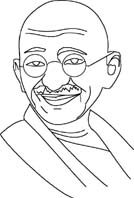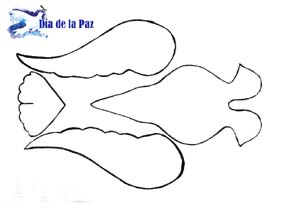ACTIVIDADES
-Lee atentanente estas dos frases de Gandhi y coméntalas con el profesor y tus compañeros
"La
no-violencia es la fuerza más grande que existe a disposición
del género humano"
"Nadie tiene el derecho a dominar por la fuerza al malvado; pero todos
tenemos el deber de resistirle, separándonos de él cueste lo
que cueste. Y cuando el enemigo se arrepienta, abrazadle"
Ahora, escribe lo que pienses sobre ésta:
-"La mujer es la compañera del hombre, dotada de las mismas capacidades mentales, Ella tiene derecho a participar en los más mínimos detalles en las actividades del hombre, y tiene el mismo derecho que él a la libertad"
Con esta frase Gandhi nos deja ver su concepción coeducativa de la vida. Hoy día intentamos llevar la coeducación hasta sus niveles más altos. Ahora, tú podrías hacer un estudio y preguntar en casa, a los abuelos, sobre algunas actividades que las mujeres realizan hoy día y si las hacían hace 50 años:
|
LAS MUJERES DESEMPEÑABAN CARGOS POLÍTICOS |
SI | NO |
| LAS MUJERES TRABAJABAN COMO MÉDICOS | SI | NO |
| LAS MUJERES ERAN ENFERMERAS | SI | NO |
| LAS MUJERES TRABAJABAN EN EL CAMPO | SI | NO |
|
LAS MUJERES ERAN MAESTRAS |
SI | NO |
| LAS MUJERES ERAN CIENTÍFICAS | SI | NO |
| LAS MUJERES VOTABAN EN LAS ELECCIONES | SI | NO |
| LAS MUJERES PODÍAN GOBERNAR UN PAÍS | SI | NO |
-En la siguiente frase de Gandhi se refleja muy bien su actitud pacifista en el mundo.
"La no violencia y la cobardía son términos contrarios. La no violencia es la mayor virtud, la cobardía es el mayor vicio. La no violencia siempre sufre, la cobardía provoca sufrimiento. La no violencia perfecta es la mayor valentía. La conducta no violenta no es desnaturalizante, la cobardía siempre lo es"
¿Podrías
nombrar a otras personas pacifistas del mundo o de España, a las que
aún no habiéndosele concedido el Nóbel de la Paz si han
luchado por ella? Consulta esta web:
http://es.wikipedia.org/wiki/Pacifismo
-Consuta esta dirección
y escribe los nombres de algunos pacifistas, entre los que se encuentra Gandhi.
http://es.wikipedia.org/wiki/Pacifismo
Busca dentro de estos personajes a un pacifista español y señala
la obra importante que realiza contra la guerra.
-Escribe una supuesta carta a Gandhi.
-Busca en esta otra dirección:
http://www.geocities.com/armonizaciones/pro_educa_paz.htm?200620
Haz un cuadro en el que escribirá la palabra "PAZ" en otros
muchos idiomas.
TEMA PARA EL DEBATE
Gandhi ayunó en señal de protesta contra el derramamiento de sangre. ¿Qué otras formas de protestas conoces? ¿Crees que son realmente fructíferas?
IDIOMA
- Look at the family tree
of Gandhi and then make your own family tree.
http://web.mahatma.org.in/familytree/familytree.jsp?link=ft
-Translate into spanish
the following sentence of Gandhi:
"Nonviolence is the greatest
force at the disposal of mankind. It is mightier than the mightiest weapon
of destruction devised by the ingenuity of man."
-Read:
A Brief History
of Mohandas K. Gandhi
Mohandas K. Gandhi was born in 1869 to
Hindu parents in the state of Gujarat in Western India. He entered an arranged
marriage with Kasturbai Makanji when both were 13 years old. His family later
sent him to London to study law, and in 1891 he was admitted to the Inner
Temple, and called to the bar. In Southern Africa he worked ceaselessly to
improve the rights of the immigrant Indians. It was there that he developed
his creed of passive resistance against injustice, satyagraha, meaning truth
force, and was frequently jailed as a result of the protests that he led.
Before he returned to India with his wife and children in 1915, he had radically
changed the lives of Indians living in Southern Africa.
Back in India, it was not long before he was taking the lead in the long struggle
for independence from Britain. He never wavered in his unshakable belief in
nonviolent protest and religious tolerance. When Muslim and Hindu compatriots
committed acts of violence, whether against the British who ruled India, or
against each other, he fasted until the fighting ceased. Independence, when
it came in 1947, was not a military victory, but a triumph of human will.
To Gandhi's despair, however, the country was partitioned into Hindu India
and Muslim Pakistan. The last two months of his life were spent trying to
end the appalling violence which ensued, leading him to fast to the brink
of death, an act which finally quelled the riots. In January 1948, at the
age of 79, he was killed by an assassin as he walked through a crowed garden
in New Delhi to take evening prayers
-Complete the chart:
|
YEARS
|
ACTIONS
|
|
1869
|
|
|
1882
|
|
|
1891
|
|
|
1915
|
|
|
1947
|
|
|
1948
|
-Colorea este dibujo y escribe
debajo de él una frase de Gandhi sobre la guerra sacada de la web:
"Frases importantes sobre la guerra"
con esta dirección:
http://archivoatrabilioso.blogspot.com
-Construimos una paloma de la paz con cartulina

